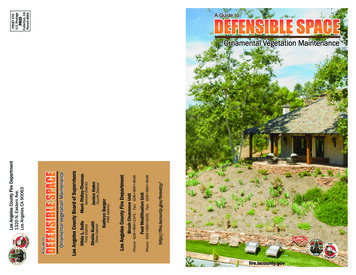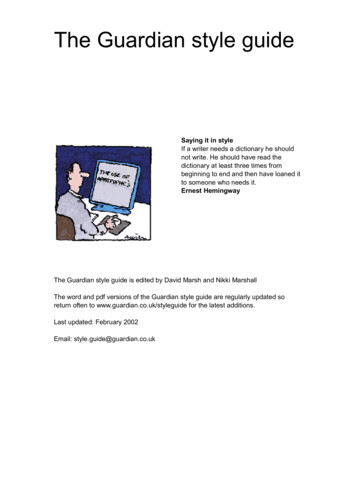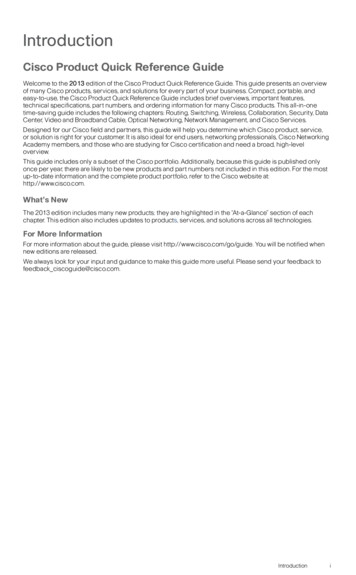
Transcription
Janice HahnSheila Kuehlhttp://fire.lacounty.gov/forestry/Phone: 626 969 5205. Fax: 626 969 4848Fuel Modification UnitPhone: 626 969 2375. Fax: 626 969 4848Brush Clearance UnitLos Angeles County Fire DepartmentFifth DistrictKathryn BargerFourth DistrictSecond DistrictFirst DistrictThird DistrictMark Ridley-ThomasHilda L. SolisLos Angeles County Board of SupervisorsDEFENSIBLE SPACEDEFENSIBLEA Guide toLos Angeles County Fire Department1320 N. Eastern Ave.Los Angeles CA 90063A Guide toDEFENSIBLE SPACEDEFENSIBLEfire.lacounty.gov
Your Home Is Your Castle!The Los Angeles County FireDepartment takes great measuresto protect you and your propertyfrom wildfire; yet, we need yourhelp in preparing your home andlandscape to be wildfire ready.Hardening your home and addressing ornamental vegetation adjacent toyour structure are critical elements in structure survivability.Defensible Space requirements are outlined in the Fire Code, but there ismore to defensible space than clearing or maintaining native brush. Manyhomeowners have increased their fire risk by planting or not maintainingtheir ornamental landscape. Creating and maintaining defensible space isessential for increasing your home’s chance of surviving a wildfire. It’sthe buffer that homeowners are required to create on their propertybetween a structure and the plants, brush, and trees or other itemssurrounding the structure that could catch fire. This space is needed toslow the spread of wildfire and improves the safety of firefightersdefending your home. In high fire hazard areas, the maintenancerequirements may extend to 200 feet from structures.Plant DensityFocus on mature plant size,form and planting density bytype. Here, woody plantelements are broken up withthe use of small grasses andhigh-moisture succulents. Matforming woody plants, such asthe Emerald CarpetManzanita and AustrofloraFanfare Grevellia are used insmall drifts. Remember thateven a well-chosen plantpalette requires maintenance.XeriscapeGarden accents, secondarypathways and drystreambeds, such as theones shown here, are idealways to create small breaksin vegetation. They also allowaccess to landscape that maybe otherwise difficult tomaintain.Preventing conditions where fire can travel from adjacent fuels, through anornamental landscape to your structure, is the key to creating defensiblespace. Fire spreads through convection, conduction, radiation, andembers. Proper maintenance of ornamental vegetation reduces emberproduction, fire propagation, intensity, and duration of the approachingflames.This brochure visually details the most critical landscape conditions andclarifies what should be done to prepare your home for the greatestchance of survival. If any of these conditions are impacting your home,follow these guidelines to properly prepare and pass your next wildfiresafety inspection (Annual Defensible Space Inspection).2 Los Angeles County Fire DepartmentLandscaping Best Management PracticesLandscaping Best Management Practicesfire.lacounty.gov 11
Landscaping TipsOrnamental Landscape Maintenance ChecklistFuel LaddersThe concept of fuel ladders iscrucial to planning a firewiselandscape. No matter whatplants are chosen, providingadequate and definiteseparation between groundcovers, shrubs and trees isthe most critical considerationin the design/plant selectionprocess. Do not use largeshrubs beneath trees. Chooseplants that mature to a heightLandscaping Best Management Practicesof no more than two feetbeneath trees, rather than using pruning to maintainplants at that height. Do not plant continuoushedgerows that lead directly to structures.Native PlantsIn the past, the use ofCalifornia native plantswere unfortunatelydiscouraged. The key tousing California nativeseffectively is to chooselow-growing varieties ofall plants to be usedwithin 20 feet of thestructure. Useherbaceous plants,Landscaping Best Management Practicessucculents and smallgrasses closest the structure. Working out from the structure, you canbegin to introduce low-growing woody plants, such as the Pigeon PointCoyote Bush in the foreground. Using slightly taller plants sparingly asaccents will provide plenty of interest. As you move further away fromstructures, larger trees and shrubs can be used as long as you do notcreate fuel ladders.10 Los Angeles County Fire DepartmentVegetation Conditions:1.2.3.4.5.6.Trees touching/overhanging structure: Remove limbs within five feetof any structure, and within 10 feet from any chimney outlet. Trimtrees up to six feet or one third their height.Vines and climbing plants: Remove from all structures.Hedges and screens between homes: Reduce and maintain to aheight of no greater than eight feet.Large shrubs under windows: Maintain 12-inch separation underwindows.Ground cover: Maintain at 18-inch maximum height.Dead vegetation: Remove all dead material within 100 feet ofstructures.Specific Plants:1.2.3.4.5.6.Italian Cypress: Remove if center of trunk is within 10 feet of anystructure.Junipers: Remove within 10 feet of any structure.Bougainvillea: Remove from all structures.Wisteria/Trumpet Vines/Creeping Fig, etc.: Remove from allstructures.Palms: All palm trees should be free of dead or dying fronds.Consider removing unmaintained trees.Pines: Maintain all pines free of dead material.Additional Resources:Department ResourcesReady! Set! Go!https://www.fire.lacounty.gov/rsgFuel Modification vision/forestry-fuel-modification/Brush Clearance Inspection n/fire-hazard-reduction-programs/Additional ResourcesWildfire in the West Videohttp://www.denverpost.com/fireline/ci afelandscapes/fire.lacounty.gov 3
Ornamental Landscaping RecommendationsTrees touching oroverhanging structuresTrees must be pruned back toprovide a five-foot minimumseparation from the roof.Chimneys require a 10-footseparation.Vines and climbing plantsAll plants must be removedfrom any structure.How to choose plantsChoose a palette withpredominantly low-growingplants, mixed with succulentsand herbaceous groundcovers, which are ideal whendesigning a fire-wiselandscape. This minimizesmaintenance, such as regularpruning and leaf litter removal.It is best to choose plants thatmature to the desired heightsrather than using pruning asLandscaping Best Management Practicesan alternative. Use small trees(less than 20 feet tall) sparingly as focal points within 20 feetfrom structures.HardscapeHedges and screensReduce any hedges or screensto a maximum height of eightfeet. A five-foot wide walkingpath must be provided aroundthe entire structure.4 Los Angeles County Fire DepartmentLocating hardscapefeatures, such as walkways,patios and drivewaysabutting structures, is thebest way to eliminatereceptive fuel beds againststructures. Ideally,eliminating anythingflammable within five-feet ofany structure is best. Whennot possible, gravel mulchand low-growingLandscaping Best Management Practicesherbaceous plants andsucculents can be used against structures. Keep woodyshrubs and perennials away from structures.fire.lacounty.gov 9
Landscaping TipsLandscapeDesignWhen designing anew landscape ormaintaining anestablishedlandscape,remember toaddresseverythingsurrounding thestructure. View itfrom all angles. The shrubs and trees on the side of thishome and in the frontyard and the backyard presentspecific challenges as they continue to grow. Misplacedtrees and large shrubs should be considered for removal.These plants can contribute to a leaf litter accumulationagainst the structure as well as on the roof.Trees and shrubs betweenhomesPlants must be pruned back toprevent overhang onto anystructure. Provide five-footbreaks in horizontal continuitywhere appropriate (near theend of structures).Maintain ground coverGround cover must bemaintained at a maximumheight of 18 inches and bekept free of dead material.Maintaining TreesEven existing pine trees canbe maintained to reducetheir potential hazard.Meticulous needle removalfrom the ground, roof andrain gutters is most effectiveif done every two weeks.Proper watering and pruningto maintain overall healthgreatly reduces the hazardthis pine could present.Never top trees; always seekLandscaping Best Management Practicesservices from certifiedarborists for recommendations related to pruning.8 Los Angeles County Fire DepartmentMaintain shrubs free ofdead woodRemove all dead wood andprovide a minimum space of12 inches under windows.Prune trees to provide fivefeet of separation from thestructure.fire.lacounty.gov 5
Ornamental Landscaping RecommendationsPalm frondsRemove Italian CypressRemove dead or dyingpalm fronds from treesand consider tree removal.Remove any plants wherethe center of the trunk islocated within 10 feet of anystructure.Maintain all treeswithin 100 feet ofstructuresRemove JunipersClear Junipers from within10 feet of any structure.Remove all dead wood,especially from pine andeucalyptus trees.Remove any portion thatis within five feet of anystructure.Bougainvillea, TrumpetVines, Creeping Fig andWisteriaRemove any plants that areattached to combustiblestructures.6 Los Angeles County Fire DepartmentTrees along fire accessstreets or drivewaysTrees must be maintainedto provide a minimum of16 feet of verticalclearance. Oak trees maybe maintained at 13 1/2feet.fire.lacounty.gov 7
A Guide toAA Guide to Guide to fire.lacounty.gov Los Angeles County Fire Department 1320 N. Eastern Ave. PLos Angeles CA 90063 Los Angeles County Board of Supervisors Kathryn Barger Fifth District Los Angeles County Fire Department Brush Clearance Unit Fuel Modification Unit Ph










